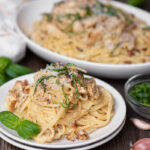Chicken Carbonara
You will love this rich and decadent Chicken Carbonara. It's made with crispy bites of tender chicken breasts, tantalizing bits of Italian bacon, perfectly cooked pasta, and the most flavorful creamy sauce.
Servings: 6 servings
Ingredients
For the pasta:
- 1 tablespoon kosher salt
- 1 pound spaghetti
To make the carbonara:
- 1 pound boneless skinless chicken breasts pounded to 1/2 inch thick
- salt and pepper
- 1/4 cup all-purpose flour
- 3 eggs room temperature
- 1 cup parmesan finely grated - highly recommend using a microplane
- 3/4 cup heavy cream
- 4 ounces bacon, pancetta, guanciale, or rancher's bacon diced
- 2-4 cloves garlic minced
- 1 tablespoon butter
- 1 tablespoon olive oil
- for garnish: fresh basil sliced into thin ribbons and more parmesan cheese
Instructions
- Prepare ingredients: Ensure all ingredients are chopped/measured/prepared before you start cooking. 1. Heat a large pot of water with 1 tablespoon kosher salt. Bring to a boil. Then reduce the heat to maintain a gentle simmer until you are ready to bring it back to a boil to cook the 1 pound spaghetti.2. Lay 1 pound boneless skinless chicken breasts in between two layers of plastic wrap and flatten to 1/2" thick using a meat tenderizer or a rolling pin. Coats both sides with salt and pepper. Add 1/4 cup all-purpose flour to a large plate and dredge the chicken in the flour to coat. Set it on the flour plate until you are ready to cook. 3. In a medium-sized bowl, combine 3 eggs, 1 cup parmesan, and 3/4 cup heavy cream. Whisk to combine.
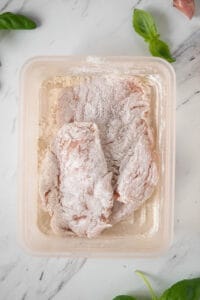
- Start cooking bacon: Heat a large sauté pan or cast iron skillet over medium-high heat. Cook 4 ounces bacon, pancetta, guanciale, or rancher's bacon until it begins to slightly turn golden brown and release hot grease, about five minutes. Add the 2-4 cloves garlic and stir to coat. Push the bits of your meat to the edges of the pan.
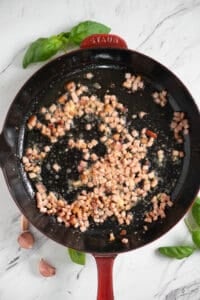
- Start cooking chicken: Add 1 tablespoon butter and 1 tablespoon olive oil to the center of the hot pan and place the prepared chicken on the hot surface. Allow it to cook, mostly undisturbed, until golden brown on the bottom. You can use tongs to slightly lift the chicken to allow the hot butter/oil/grease to get underneath.
- Start cooking pasta: When the chicken is about ready to flip, increase the heat under the pot of water to high to bring it to a boil again, and add the pasta.
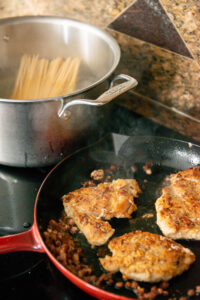
- Finish the chicken: Flip the chicken and brown the other side. When done, transfer the cooked chicken to a cutting board. Remove the sauté pan from the heat.Slice the browned chicken into small, thin, bite-sized pieces. Add the chicken back to the pan along with the cooked bacon.
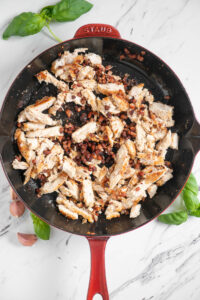
- Reserve pasta water: Prior to draining the pasta, add at least 1/2 cup of the salted cooking water to a measuring cup to thin the sauce later on.
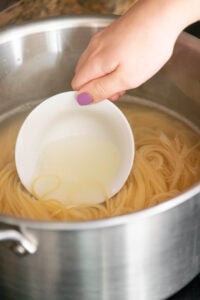
- Mix hot pasta with sauce: Drain the pasta and immediately return it back to the pot. With the heat off, add the egg mixture to the hot ingredients and stir very well to combine. The hot pasta will cook the egg enough to turn it into a wonderful sauce without scrambling the egg. Thin with reserved pasta water, as needed (or wait until you've added the chicken and bacon and see if it needs thinned then).
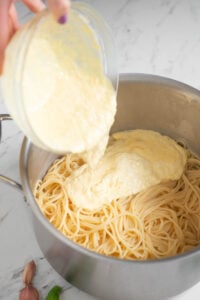
- Add meat and serve: When the sauce is ready, add the chicken and bacon mixture, scraping any oil and bits that remained in the pan. Season with salt and pepper, to taste. Top with fresh basil and additional grated parmesan, if desired.
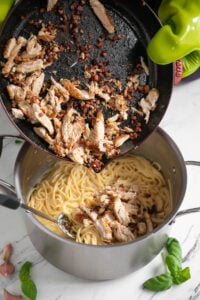
Notes
- Freshly grated parmesan always melts better than pre-shredded. Either will work for this recipe, but finely grated cheese from a block is best.
- For the best carbonara, the trick is to transfer the hot pasta directly out of the pot of salted boiling water and into the sauce, away from additional direct heat to avoid curdling the egg. This can be done either in the pasta pot or in a dish.
- Although any kind of pasta can be used, spaghetti is really your best choice because it has a sufficiently large ratio of surface area to volume. This means that the cylindrical shape of each spaghetti noodle will maximize it's contact with the sauce, thus ensuring the sauce gets properly cooked.
- To avoid having the egg scramble, never add the egg in carbonara sauce over direct heat. You use the heat from the freshly cooked pasta to heat and cook the sauce. You can also avoid curdling by setting your eggs out at room temperature a few hours before using them. That will decrease the temperature delta between your eggs and the hot pasta.
- Leftover pasta carbonara can be reheated, but you must do it gently. My recommendation for reheating would be to either heat on the stove, covered, over very low heat. The alternative would be to heat in the microwave at a low power, say 30-50%, and to stir it often to ensure it gets heated evenly.
Nutrition
Calories: 746kcal | Carbohydrates: 60g | Protein: 38g | Fat: 39g | Saturated Fat: 18g | Polyunsaturated Fat: 2g | Monounsaturated Fat: 8g | Trans Fat: 0.1g | Cholesterol: 200mg | Sodium: 1739mg | Potassium: 532mg | Fiber: 3g | Sugar: 3g | Vitamin A: 820IU | Vitamin C: 2mg | Calcium: 254mg | Iron: 2mg
